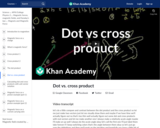
Understanding the differences between the dot and cross products. Created by Sal Khan.
- Subject:
- Physical Science
- Physics
- Material Type:
- Lesson
- Provider:
- Khan Academy
- Provider Set:
- Khan Academy
- Author:
- Sal Khan
- Date Added:
- 08/08/2008

Understanding the differences between the dot and cross products. Created by Sal Khan.
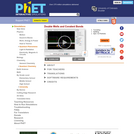
Explore tunneling splitting in double well potentials. This classic problem describes many physical systems, including covalent bonds, Josephson junctions, and two-state systems such as spin 1/2 particles and ammonia molecules.

Word Count: 251888
(Note: This resource's metadata has been created automatically by reformatting and/or combining the information that the author initially provided as part of a bulk import process.)

Based on College Physics by Open Stax
Short Description:
This is a custom edition for Practical Physics Physics 1104 at Douglas College. It has been modified from OpenStax College Physics.
Long Description:
This textbook has been customized for Physics 1104 at Douglas College. That course is intended for students who have not taken Physics previously or who have taken some secondary school Physics and want a review. The areas to be covered are mechanics (one and two dimensional motions; vectors; rotational motion; simple machines; work, energy, and power; momentum; equilibrium; Hooke’s law; collisions; circular motion; hydrostatics), heat (thermometry; heat transfer; thermal properties of matter), and electricity (electrostatics; direct current concepts and basic circuits).
This book is based on Open Stax’s College Physics. It is organized such that topics are introduced conceptually with a steady progression to precise definitions and analytical applications. The analytical aspect (problem solving) is tied back to the conceptual before moving on to another topic. Each introductory chapter, for example, opens with an engaging photograph relevant to the subject of the chapter and interesting applications that are easy for most students to visualize.
Word Count: 287459
(Note: This resource's metadata has been created automatically by reformatting and/or combining the information that the author initially provided as part of a bulk import process.)
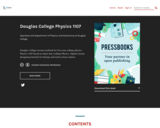
Short Description:
Douglas College custom textbook for first year college physics. Physics 1107 based on Open Stax College Physics. Algebra based, designed primarily for biology and earth science majors.
Word Count: 222181
(Note: This resource's metadata has been created automatically by reformatting and/or combining the information that the author initially provided as part of a bulk import process.)

Short Description:
College Physics is organized such that topics are introduced conceptually with a steady progression to precise definitions and analytical applications. The analytical aspect (problem solving) is tied back to the conceptual before moving on to another topic. Each introductory chapter, for example, opens with an engaging photograph relevant to the subject of the chapter and interesting applications that are easy for most students to visualize.
Long Description:
College Physics is organized such that topics are introduced conceptually with a steady progression to precise definitions and analytical applications. The analytical aspect (problem solving) is tied back to the conceptual before moving on to another topic. Each introductory chapter, for example, opens with an engaging photograph relevant to the subject of the chapter and interesting applications that are easy for most students to visualize.
Word Count: 254796
(Note: This resource's metadata has been created automatically as part of a bulk import process by reformatting and/or combining the information that the author initially provided. As a result, there may be errors in formatting.)
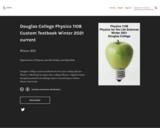
Winter 2021
Short Description:
Douglas College custom textbook for first year college physics. Physics 1108 based on Open Stax College Physics. Algebra based, designed primarily for biology majors transferring to Simon Fraser University.
Word Count: 306375
(Note: This resource's metadata has been created automatically by reformatting and/or combining the information that the author initially provided as part of a bulk import process.)
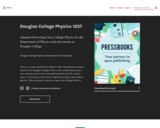
Adapted from Open Stax College Physics by the Department of Physics and Astronomy at Douglas College
Short Description:
This is a custom textbook for Physics 1207 Introductory General Physics II at Douglas College. This is the second semester of a non-calculus based course intended primarily for life science majors. It focuses on electricity, magnetism, optics and modern physics. This textbook is based on Open Stax College Physics.
Long Description:
.
Word Count: 350922
(Note: This resource's metadata has been created automatically by reformatting and/or combining the information that the author initially provided as part of a bulk import process.)

Adapted from Open Stax College Physics by the Department of Physics and Astronomy at Douglas College
Short Description:
This is a custom textbook for Physics 1207 Introductory General Physics II at Douglas College. This is the second semester of a non-calculus based course intended primarily for life science majors. It focuses on electricity, magnetism, optics and modern physics. This textbook is based on Open Stax College Physics.
Long Description:
.
Word Count: 344593
(Note: This resource's metadata has been created automatically by reformatting and/or combining the information that the author initially provided as part of a bulk import process.)

In this activity, students use the binary number system to transmit messages. Two flashlights are used to demonstrate how astronomy spacecraft to transmit images and other scientific data to Earth. This activity is part of Unit 4 in the Space Based Astronomy guide that contains background information, worksheets, assessments, extensions, and standards.

Students identify the actual colors of objects bathed in monochromatic light and learn how three colors of light can be combined to produce colors ranging from black to white. Students see how space observatories make use of monochromatic filters to collect data on the color of objects in space. The activity is in unit four of the "Space-Based Astronomy" guide that contains background information, worksheets, assessment activities, extensions, and alignment to national education standards.

In this activity, students simulate how light collected from a space object converts into binary data and reconverts into an image of the object. A pencil and paper activity demonstrates how astronomical spacecraft and computers create images of objects in space. This activity is part of Unit 4 in the Space Based Astronomy guide that contains background information, worksheets, assessments, extensions, and standards.

Students see how surface tension can enable light objects (paper clips, peppercorns) to float on an island of oil in water, and subsequently sink when the surface tension of the oil/water interface is reduced by the addition of a surfactant; such as ordinary dish soap.
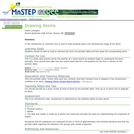
Drawing two dimensional images of an atom.
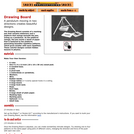
The Drawing Board consists of a marking pen that remains stationary and a platform that swings beneath the pen, acting as a pendulum. As the platform swings, the pen marks a sheet of paper that is fastened to the platform, generating beautiful repetitive patterns. These colorful designs contain hidden lessons in physics. This resource includes instructions for making a large-scale Drawing Board as well.

Students use a compass and a permanent magnet to trace the magnetic field lines produced by the magnet. By positioning the compass in enough spots around the magnet, the overall magnet field will be evident from the collection of arrows representing the direction of the compass needle. In activities 3 and 4 of this unit, students will use this information to design a way to solve the grand challenge of separating metal for a recycling company.

The course provides the technological background of treatment processes applied for production of drinking water. Treatment processes are demonstrated with laboratory experiments.

To demonstrate how unimportant inertia is in plate tectonic problems, as part of a lecture, we calculate momentum and moment of inertia of both a supertanker and a plate. A supertanker running into a dock will do more than a million times more damage than a plate. This activity addresses student misconceptions and has a small quantitative component.
(Note: this resource was added to OER Commons as part of a batch upload of over 2,200 records. If you notice an issue with the quality of the metadata, please let us know by using the 'report' button and we will flag it for consideration.)
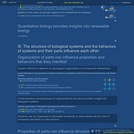
Biological systems (e.g. cells) can make stochastic transitions between phenotypes (e.g. states of relatively increased or decreased drug resistance). This means that an initially drug-sensitive population can generate relatively drug-resistant subpopulations. This video presents a metronomogram, which is a tool for understanding whether such stochastic transitions can provide an opportunity for therapeutic treatment. Citation: Liao D, Estevez-Salmeron L, and Tlsty TD (2012) "Conceptualizing a tool to optimize therapy based on dynamic heterogeneity," Phys. Biol. 9:065005.

This course covers the fundamentals of Newtonian mechanics, including kinematics, motion relative to accelerated reference frames, work and energy, impulse and momentum, 2D and 3D rigid body dynamics. The course pays special attention to applications in aerospace engineering including introductory topics in orbital mechanics, flight dynamics, inertial navigation and attitude dynamics. By the end of the semester, students should be able to construct idealized (particle and rigid body) dynamical models and predict model response to applied forces using Newtonian mechanics.